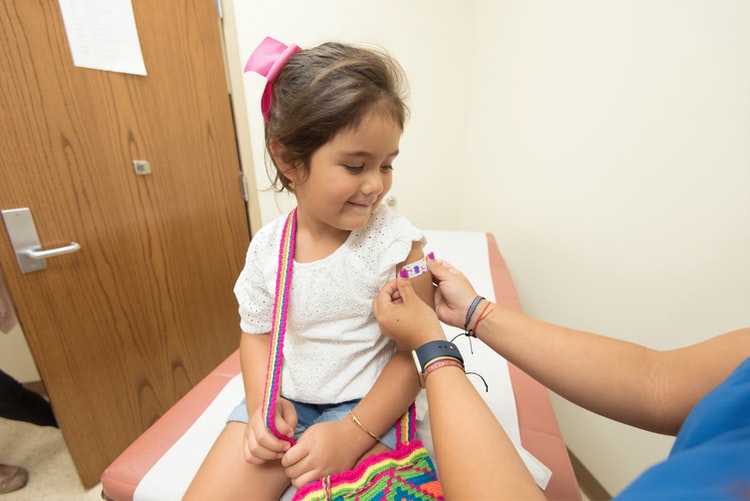11 Min Read
10 Tips to Help Your Child Live a Healthy Life

washIf there’s one thing we know about health, it's that it’s fragile and needs attention around the clock. Being a stay-at-home or working mom means having to juggle several tasks in a day. But in that mix, it is important to incorporate a healthy lifestyle not just for yourself but the whole family.
Children are easily influenced at a young age—what better time to nurture a healthy lifestyle than at their prime? It may not be easy at first but if you practice what you preach, the journey to good health with your child will be rewarding.
Before you begin, keep an open mind about the different ways you’ll be exploring to get to your destination. More importantly, give your child time and patience when certain moments don’t go as planned.
Many youngsters are obese or overweight, and it’s crucial to help them get their health on track. Simple lifestyle changes can turn into significant habits. So how do you teach children about a healthy lifestyle? We answer that and more right here in 10 easy ways.
10 Good Health Tips for a Child: Doing It the Easy Way

The best way to make a wholesome lifestyle a priority is to start when children are young. That way, it’s easier to inculcate solid habits and instill valuable lessons on the perks of good health. Start on building the lifestyle of a healthy family at home to set children on the right path. So what are 10 tips for a healthy lifestyle for kids? Well, let’s get right to it.
1. Teach Your Child the Importance of Good Health
At a young age, children can’t help doing certain things that come naturally to them. Offering advice early helps create a conscious effort in their minds when a situation presents itself again. For instance, it is important for a child to not share their utensils or cutlery with others in their class during lunch break. Sharing these everyday items can encourage the exchange of germs, which is something you don’t want.
When you pack your child’s lunch, include a pack of tissues and make them understand the importance of sneezing into one when they catch a cold. Advise them to also wipe their hands dry after using soap and water. Handwashing is a crucial step in keeping germs at bay.
After playtime, visiting the bathroom, or before/after eating, parents should make handwashing a household rule that must also be followed at school, too. Turn handwashing into a fun activity by doing it with them at first before they get a hang of it. During the act, sing the alphabet or the ‘Happy birthday’ tune while they work their hands into a soapy lather. Once the tune ends, their hands will now be squeaky clean.
Direct them to focus on the areas between their fingers, under their nails, and washing as high up as their wrists to get rid of any residual germs. This practice can help slow down the spread of germs and reduce the likelihood of falling sick or infecting others.

2. Build a Strong Immune System
Good health is only the result of a strong immune system. It is like an antivirus software of our bodies that is programmed to identify and eliminate potential threats. To keep this “software” running smoothly, we have to regularly update it, just like we do for our everyday gadgets.
Different factors come into play to help our bodies fight off disease-causing germs. How often we exercise, what we eat, how we manage stress, how many hours of sleep we get in a day, and how often we take a break to reset, determines the strength of our immunity. Children tend to mimic what adults do, so if you want them to start early, make an example of yourself with these changes:
Swap TV time for family time
Instead of eating meals in front of the TV, make family time around the dinner table a ritual.
Swap meat and processed sugar with nature’s finest
Replace red meats with whole foods such as veggies and leafy greens. Cut down on sugar by replacing ice cream with homemade sorbet, candy with freshly cut fruit, and milk chocolate with dark chocolate.
Get moving as a family
When you exercise, let your child join in as well for at least 15 to 20 minutes a day, which you can take up to 30 minutes every alternate day. Encourage outdoor activities such as cycling, jogging, long walks, playtime at the park, or trekking. Do it as a family or with a neighbor and their kids to indulge in fun physical activity together. It’s also a great time to bond with your child and find out what they love to do.
Consider supplementing only if needed
Most pediatricians will not be on board with giving children vitamin supplements if their diets are already rich in whole foods. To find out if your child is vitamin deficient, first get a physical examination and the required tests done.
Based on the results, change your child’s diet early by making easy, nutritious food swaps. Get the family interested in a whole foods diet, which is touted for improving energy, nourishing the body, and fortifying the immune system:
- Replace high-carb foods with complex carbs such as brown rice, multi-grain bread, quinoa, sweet potatoes, beans, legumes, and whole-wheat pasta.
- Replace white sugar with organic cane sugar, date sugar, or coconut sugar.
- Replace sugary cereal with granola and oats.
- Replace full-fat dairy-based milk and cheese with plant-based versions.
- Replace meat with tofu, plant-based meat, tempeh, grains, and veggies.
3. Look Out for Signs of Stress or Anxiety

Children, just like adults, can experience bouts of stress and anxiety. Learn to identify the symptoms early to help them cope with what’s troubling them. Exams, homework, peer pressure, or even moving to a new place can trigger these feelings.
Identify the signs
Keep an eye on how your child speaks, acts, eats, and interacts with others. Avoid ignoring any signs as trivial since children tend to internalize a lot of what they’re going through. It may not show in obvious ways so it’s wise to be on guard to spot behavioral changes.
Approach your child
Once you identify the signs, approach your child from a place of love and concern before prompting them to open up. If at first it doesn’t work, give them some time to come to you. It always helps to constantly tell a child that they can come to you for anything and that telling them won’t make you mad. Create an open channel between you and your child that makes them comfortable to confide in you. Don’t shy away from getting expert help if the signs are severe.
Ways to cope
To help your child cope, encourage downtime outdoors, taking a trip to the mall, playing their favorite board game, reading, camping, or keeping a journal. No two children will benefit from the same methods so find other ways to connect with your child to see what works for them.
4. Create a Good Sleep Routine

Getting a good night’s rest is crucial for a child, especially during their school years. Studies show that sleep deprivation can lead to several health problems such as poor concentration, depression, obesity, low energy levels, diabetes, and high blood pressure, to name a few.
Children these days aren’t getting enough sleep like they used to back in the day because of newer distractions. Develop a healthy sleeping schedule for young and older children by setting a time for watching TV, playing video games, and using their phones. It’s best to limit the use of technology, especially when children are young. Encourage them to read more books and play with toys to build their cognitive and imaginative skills.
Uncertain times in our lives can disrupt a child’s sleeping patterns. Whether it’s the loss of someone close or being confined indoors (as is the case in a pandemic), sleep won’t come easy to young children. Understand their fears and communicate to them about how things will get better. Focus on things they can control, rather than what they can’t.
For better sleep, invest in a pretty night light or fun glow-in-the-dark stickers that can help create a warm, cozy haven. Sleep sound machines can also help lull children into a restful sleep, thanks to the soothing sounds. A child’s bedroom that is filled with thoughtful additions such as these can greatly impact their sleeping schedules.
If children share the same room, it would be wise to create unique themes for each of them, depending on what they find comfort in.
5. Make Lunchtime a Meal to Look Forward To

To make foods interesting and fun to eat, use cute little food cutters, molds, and lunchboxes. Cut everyday fruits and veggies into cool bite-sized morsels and mold rice or mashed potatoes into interesting shapes. The more colorful and creative you make lunch, the higher the chances of scoring big with your child.
Not only will they be excited about lunchtime but also readily eat healthy foods. You can also include a couple of healthy snacks in their lunchboxes such as dried fruit, nuts, sugar-free protein bars, or veggie sticks with a homemade dip.
Experiment with different cuisines to keep their appetites happy. Variety as they say is the spice of life! The best part? Spending time with family to create meals together. Learning early is the best way to encourage children to help out in the kitchen when they’re older. The same applies to doing the dishes together and prepping the dinner table
6. Practice Gratitude

With so much happening around us, it’s important to practice gratitude as adults and even children. How do you keep a child healthy spiritually and mentally? At their age, children are impressionable. Teaching them about what it is to be grateful can significantly change their mindset. Start with small things like being thankful for waking up to another beautiful day, being loved and appreciated by family, having so many toys and clothes, etc.
Benefits of journaling
Maintain a journal or diary with your child to practice daily gratitude. They can read theirs out loud to you every day to manifest feelings of true gratitude. Spend 10 minutes a day to listen to what your child has to say and appreciate them for putting so much heart into their list.
To put down one thing of gratitude a day is a great start before children can turn those intentions into elaborate thoughts when they reach their mid to late teens. Gratitude will help them see life from a purer standpoint and manage their feelings better.
Uplifting habits
Channeling one’s thoughts and emotions will be easier when gratitude finds a place in one’s heart. To further amplify a mindful approach to nurture the spirit and mind, practice meditation and yoga with your child with simple techniques to improve breathing and posture. These exercises can do so much good for the mind and body when practiced several times a week.
Embrace the outdoors
Spending more time outdoors can put into perspective a compassionate and thankful attitude towards mother nature. Man’s destruction has reduced the planet to more of a suburbian space than natural habitat. Take more treks, hikes, and travel to less crowded cities. Children are innately drawn to fascinating details, and amidst nature is a great place to start.
7. Make Breakfast the Most Important Meal of the Day

Eating breakfast helps fuel the mind and body during those first crucial hours of the day when we’re most active. Make it a habit to sit down through breakfast without rushing to finish. Remember, it’s not a race! Mindful eating is important to slowly restart your digestion after a night’s rest.
Teach your child to eat mindfully and chew food several times before swallowing. Incorporate high-fiber foods, nut butter, whole-wheat toast, fruits, and freshly squeezed juice as part of your family’s daily breakfast. Doing so will help boost brain function, sustain energy levels, and keep cholesterol levels under control.
8. Choose the Right School Supplies to Avoid Long-Term Health Issues
The wrong backpacks aren’t easy to carry between home and school, especially when they're stuffed with books, eatables, and school supplies. Choose a backpack with several compartments so that weight is evenly distributed. The ideal backpack should be no wider than a child’s torso and mustn’t hang below the waist.
Look for a backpack with compression straps to minimize pressure on the shoulders. If your child has to walk to school, tread snowy streets, or climb stairs frequently, a backpack on wheels can help lessen the strain.
9. Understand Childhood Illnesses

How do you keep your child healthy from unpredictable illnesses? There’s not much you can do about head lice or chickenpox since children are always around their classmates or friends. It’s easy to transfer these illnesses between children, but you can always equip yourself with what to do in such situations.
It would also be wise to visit your family pediatrician to find out about the immunizations your child will need and the best time to get them administered. Preventing diseases that are avoidable when a child is young can help their body fight off infections better.
10. Make Hydration a Priority
Children don’t drink as much water as they should in a day. We’re guilty of missing our daily quota sometimes! Keeping your body hydrated is as essential as getting adequate sleep. Here’s why you’ll want to make sure you and your child get plenty of H20 every day:
- Improves digestion when consumed before and after a meal
- Regulates heartbeat, body temperature, and normalizes blood pressure
- Prevents constipation caused by dehydration
- Helps carry vital nutrients and oxygen to the cells
- Protects the joints, organs, and tissues
- Maintains the balance of electrolytes
- Flushes harmful toxins from the bladder
Another way to consume water is through salads or homemade cold-pressed juices. Forgot to drink more water today? Just eat it! That way your body gets it from different sources throughout the day. Children will also benefit from the variety to make it easy to stay hydrated. It’s even more crucial to load up on water after a day of rigorous activity and excessive sweating.
We hope that these 10 ways to stay healthy will help you arm yourself better with how to keep your child healthy. Being vigilant and creating a safe, clean space for children at home can foster healthy habits as they grow up. As moms, we have to be on our toes when it comes to looking out for our children.

Don’t rush yourself to meet these goals for your child. Take it one day at a time! Having a support system in place can greatly benefit a child in the long run. Share your ideas and thoughts with other moms in your life and swap hacks on how to help your children grow up into healthy adults.
We found that joining hands with like-minded individuals can help with how to get started and progress. Look towards social media for groups of moms in your area (or even around the country), which can be a great starting point for newbies. No one expects you to be an expert from day one, so give yourself credit for trying to be such a conscious, awesome parent!



